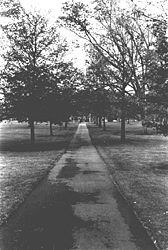

Over the summer, Grounds facilities completed a major project of renovating all the brick paths that run through Tappan Square. The cracked and nibbled walkways were smoothed over to become sleek trails fit for the advent of the 21 century.
While running through Tappan Square on the way to a 9 a.m. class, spilling coffee from a hastily closed receptacle-heat protection unit, it is difficult to notice the changes that have occurred beneath our feet. However, a look at Tappan Square before it was Tappan Square would give us pause.

In the early days, what is now called Tappan Square was a forest of beech-maples. The first clearing in the area was located at what is now the southeast corner of campus and was begun April 16, 1833, by Peter Pindar Pease.
Pease was the first colonist in that area and his log cabin stood almost exactly on the space now occupied by the bandstand. Shortly thereafter, most of the trees were cleared and the land became an eyesore which President Fairchild referred to as "stumpville." In 1836, the College planted 50,000 mulberry trees and, as part of the "Learning and Labor" tradition, students were expected to aid in the production of silk. Though the clay soil made that particular job difficult, peach trees were introduced and plots were rented to students for use as gardens. The only tree left from the native forest was an elm sapling in the southeast corner which grew to become the Historic or "President's" Elm. The tree was cut down in 1971 due to a rash of Dutch Elm disease in the region and the vacancy was filled by a patch of pansies.
The present state of Tappan Square is maintained by Dennis Grieve, grounds manager, and his gang of nine landscapers who whirl around campus in those tiny silver Daihatsus. Grieve, a horticulturalist formerly employed by the Smithsonian Institute, appreciates the natural legacy of Tappan Square.
Catastrophic events like the Dutch Elm disease epidemic in the late 60s and early 70s affect current landscaping techniques; historical moments like the cutting of the "President's" Elm instruct the practice of diverse planting in the 13-acre space as well as the entire campus.
Insofar as Tappan reflects a history of land management, Grounds now prefers mowing and composting autumn leaves as well as the practice of integrated pest management principles, which view a site holistically and resort to the use of chemical controls only as a last resort. Grieve also explains that Tappan's assorted collection of trees, including Magnolias, Weeping Willows and Yellow Poplars, work to not only "soften and frame the buildings" but serve as a natural cooling system, reducing the canopy shadow by as much as ten degrees.
Though Tappan is a showplace of introduced species, Grieve sees future techniques gravitating toward the cultivation of more native plants that require less water as well as the use of grounds as an educational tool.
According to Director of Environmental Studies David Orr, Tappan Square definitely "has an instructive value." Leader of the crusade to build one of the nation's most advanced examples of environmental architecture, Orr responds to the contrast between Tappan Square and the area around the Joseph Lewis Center, which consist of both native species and edible plants, with enthusiasm. Orr suggests that we "have a conversation about landscape policies around the campus," and insists that we must be engaged in the landscape instead of walking past it on our way to class. Tappan Square's visibility and symbolic value can be an essential starting point in a discussion of the attitudes that shape our relationship to land and landscape policies.
Tappan in the olden days: Tappan has undergone major changes over the years. (file photo)
Copyright © 1999, The Oberlin Review.
Volume 128, Number 3, September 17, 1999
Contact us with your comments and suggestions.